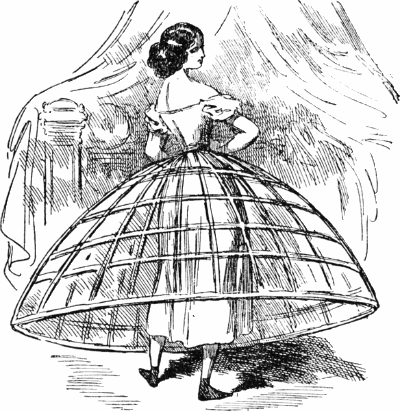|
The Breadcrumbs widget will appear here on the published site.
Trapped—literally and figurativelyThe cage crinoline first appeared in the mid 1850's and would continue to be popular until the 1870's, when it transformed into the bustle. At this time in history, women had very few rights and were generally second-class citizens. They were seen as delicate, frivolous, submissive, and intellectually inferior to men. A woman was an ornament for her father or husband to show off. Women dressed in more colorful and decorative clothing (as opposed to men who wore dark, plain suits) to display their male guardian's wealth. This stifling atmosphere did its best to confine a woman to the role of dutiful daughter and eventually dutiful wife, leaving little room for any other aspirations. You probably see where I'm going with this. Women were metaphorically caged by society, just as their bodies were literally caged by a cage crinoline. Modern fashion historians aren't the only ones who picked up on the idea of the cage crinoline as a literal cage. Here a cartoonist from the period shows how useful this cage can be for men. Just as this was a period of female intellectual and social repression, it was also a period of sexual repression (although sexual repression was a hallmark of Victorian society as a whole, not just for the women of the period). With the crinoline covering the lower half of the body, a woman's sexuality was literally in a cage, inaccessible to anyone except her husband in the privacy of the home. Interestingly, historically men weren't seen as the more sexual beings. Women were considered the sexually rapacious gender, and men were simply poor victims lured in by those pesky horny females. Thus, the crinoline can be seen as a cage confining a woman's sexuality for the protection of men, just as one would put a ravenous animal in a cage for the protection of the people around it. Interestingly, with all of its symbols of female repression, many men thought the crinoline was incredibly stupid. It was way too big, taking up all of the room in carriages and making it that much harder to get close to a woman. Which leads to the other side of the social symbolism. In an increasingly industrialized society, cities were overcrowded and with any large city comes a large crime rate. Wearing a giant cage can be seen as a form of protection against the hundreds and thousands of suspicious strangers a woman might come into contact with walking down the street. Furthermore, caging a woman's sexuality can be seen from another angle. By putting her genitals behind a cage, a woman is at least symbolically protecting herself from sexual predators. In addition to this social protection, the cage crinoline offered health benefits. Before its invention, women achieved the fashionably wide-skirted silhouette by wearing many layers of heavy petticoats. This was not only uncomfortable but unhealthy and often led to a lifestyle low on exercise and heavy on fainting. The cage crinoline offered a much better alternative. It was significantly lighter, wasn't nearly as hot, and allowed for a greater range of movement. So on the one hand the crinoline symbolized female repression, but on the other it provided a sort of female liberation. It's all relative, huh? I'm no expert on gender studies, but these are just some of my thoughts on the possible symbolism of the cage crinoline. What do you all think? Is it a greater symbol of repression? Of liberation? A combination of both? Let me hear your thoughts!
CommentsComments are closed.
|
|










